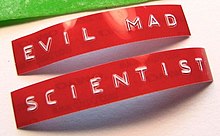
Braille is a tactile writing system used by people who are visually impaired. It can be read either on embossed paper or by using refreshable braille displays that connect to computers and smartphone devices. Braille can be written using a slate and stylus, a braille writer, an electronic braille notetaker or with the use of a computer connected to a braille embosser.

A braille embosser is an impact printer that renders text as tactile braille cells. Using braille translation software, a document or digital text can be embossed with relative ease. This makes braille production efficient and cost-effective. Braille translation software may be free and open-sourced or paid.

In the field of computing, a printer is considered a peripheral device that serves the purpose of creating a permanent representation of text or graphics, usually on paper. While the majority of outputs produced by printers are readable by humans, there are instances where barcode printers have found a utility beyond this traditional use. Different types of printers are available for use, including inkjet printers, thermal printers, laser printers, and 3D printers.

A dot matrix is a 2-dimensional patterned array, used to represent characters, symbols and images. Most types of modern technology use dot matrices for display of information, including mobile phones, televisions, and printers. The system is also used in textiles with sewing, knitting and weaving.

Daisy wheel printing is an impact printing technology invented in 1970 by Andrew Gabor at Diablo Data Systems. It uses interchangeable pre-formed type elements, each with typically 96 glyphs, to generate high-quality output comparable to premium typewriters such as the IBM Selectric, but two to three times faster. Daisy wheel printing was used in electronic typewriters, word processors and computers from 1972. The daisy wheel is so named because of its resemblance to the daisy flower.
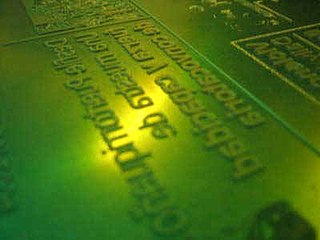
Flexography is a form of printing process which utilizes a flexible relief plate. It is essentially a modern version of letterpress, evolved with high speed rotary functionality, which can be used for printing on almost any type of substrate, including plastic, metallic films, cellophane, and paper. It is widely used for printing on the non-porous substrates required for various types of food packaging.
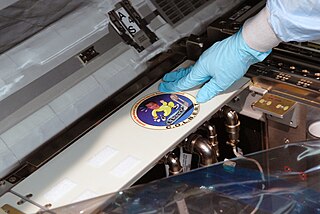
A decal or transfer is a plastic, cloth, paper, or ceramic substrate that has printed on it a pattern or image that can be moved to another surface upon contact, usually with the aid of heat or water.

In art, craft, and engineering, masking is the use of materials to protect areas from change, or to focus change on other areas. This can describe either the techniques and materials used to control the development of a work of art by protecting a desired area from change; or a phenomenon that causes a sensation to be concealed from conscious attention.

A label is a piece of paper, plastic film, cloth, metal, or other material affixed to a container or product, on which is written or printed information or symbols about the product or item. Information printed directly on a container or article can also be considered labelling.
A letter-quality printer was a form of computer impact printer that was able to print with the quality typically expected from a business typewriter such as an IBM Selectric.

Lettering is an umbrella term that covers the art of drawing letters, instead of simply writing them. Lettering is considered an art form, where each letter in a phrase or quote acts as an illustration. Each letter is created with attention to detail and has a unique role within a composition. Lettering is created as an image, with letters that are meant to be used in a unique configuration. Lettering words do not always translate into alphabets that can later be used in a typeface, since they are created with a specific word in mind.

In graphic design, page layout is the arrangement of visual elements on a page. It generally involves organizational principles of composition to achieve specific communication objectives.

A label printer is a computer printer that prints on self-adhesive label material and/or card-stock (tags). A label printer with built-in keyboard and display for stand-alone use is often called a label maker. Label printers are different from ordinary printers because they need to have special feed mechanisms to handle rolled stock, or tear sheet (fanfold) stock. Common connectivity for label printers include RS-232 serial, Universal Serial Bus (USB), parallel, Ethernet and various kinds of wireless. Label printers have a wide variety of applications, including supply chain management, retail price marking, packaging labels, blood and laboratory specimen marking, and fixed assets management.
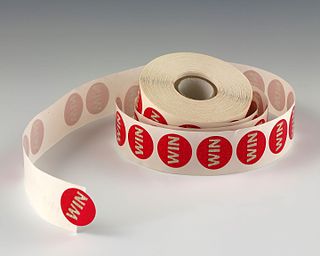
A release liner or release paper is a paper or plastic-based film sheet used to prevent a sticky surface from prematurely adhering. It is coated on one or both sides with a release agent, which provides a release effect against any type of a sticky material such as an adhesive or a mastic. Release liners are available in different colors, with or without printing under the low surface energy coating or on the backside of the liner. Release is separation of the liner from a sticky material; liner is the carrier for the release agent.
Dymo Corporation is an American manufacturing company of handheld label printers and thermal-transfer printing tape as accessory, embossing tape label makers, and other printers such as CD and DVD labelers and durable medical equipment.

The IBM Selectric was a highly successful line of electric typewriters introduced by IBM on 31 July 1961.
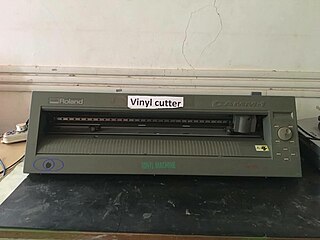
A vinyl cutter is an entry level machine for making signs. Computer designed vector files with patterns and letters are directly cut on the roll of vinyl which is mounted and fed into the vinyl cutter through USB or serial cable. Vinyl cutters are mainly used to make signs, banners and advertisements. Advertisements seen on automobiles and vans are often made with vinyl cut letters. While these machines were designed for cutting vinyl, they can also cut through computer and specialty papers, as well as thicker items like thin sheets of magnet.

Pressure-sensitive tape or pressure-sensitive adhesive tape is an adhesive tape that will stick with application of pressure, without the need for a solvent or heat for activation. It is known also in various countries as self-stick tape, sticky tape, or just adhesive tape and tape, as well as genericized trademarks, such as Sellotape, Durex (tape), Scotch tape, etc.

Security tape is a type of adhesive tape used to help reduce shipping losses due to pilfering and theft. It helps reduce tampering or product adulteration. Often it is a pressure sensitive tape or label with special tamper resistant or tamper evident features. It can be used as a ‘’security seal’’ in addition to a container closure or can be used as a security label. They are sometimes used as or with authentication products and can be an anti-pilferage seal.
